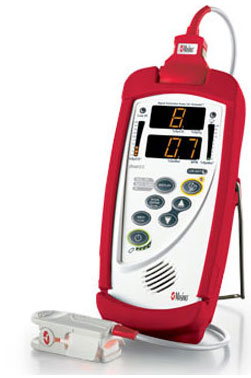 The Portable CO-Oximeter:
The Portable CO-Oximeter: When thinking of cool new gadgets we use in the emergency department, docs invariably mention expensive devices with sexy screens and fiber optics. These gadgets are glamorous. Not only do they help in high-profile situations where older technologies may not be sufficient, but bringing out this tech attracts a crowd of fellow docs, students, nurses, family and other patients – and when used successfully, these devices have been known to spur spontaneous high-fives among operators and onlookers.
But today we put the spotlight on a decidedly less glamorous device. It lacks a colorful video screen and It’s not reserved for the tough cases but rather used as a workhorse at triage, on patients that most of us would say aren’t that sick. This gadget doesn’t change the course of patient care very often – but when it does, it can be dramatic.
I’m talking about the non-invasive, portable CO-oximeter. These little devices work just as easily as your standard pulse oximeter – they’re about as small, and can be used on patient after patient – but in addition to oxygen, they can detect carboxyhemoglobin (some models also can identify methemoglobin). Their reported values of COHb correlate very well with serum levels over a wide range, and with remarkable accuracy. Since it’s impractical to send blood tests for carboxyhemoglobin levels on everyone presenting with flu-like symptoms, this gadget quickly gives docs data on important and probably under-diagnosed toxicity.
A recent trial looked at all non-critical adult patients who presented to a large academic ED (Suner, 2008). From this group they found 28 cases of carbon monoxide toxicity – 11 of which were completely unexpected. That may not sound like a lot when you consider they screened over 14,000 patients (and there were a few false positives, too). But when you think about all the patients we see in the ED with vague complaints of headache, fatigue or nausea, well, wouldn’t you want this little piece of information before sending these folks back into a potentially unsafe environment? The authors have picked up many cases of occult CO toxicity over the years, and, when the fire department surveyed these patients’ homes, they found dangerous heating conditions or faulty venting.
We remind ourselves to check for CO poisoning in the winter, or after natural disasters when patients are using alternative forms of power. But we still end up missing many cases of CO toxicity, and indeed, many facilities lack the ability to test for it at all (Hampson 2006). The CO-oximeter is an easy-to-use tool that may influence the course of care for a small but vulnerable population – at that’s why we’ve chosen it as Unsung EM Gadget of the Year.
(Disclosure – in the study cited, the CO-oximeter manufacturer, Masimo, supplied materials and funding for research assistants, and one of the study authors is an EPM advisor.)



